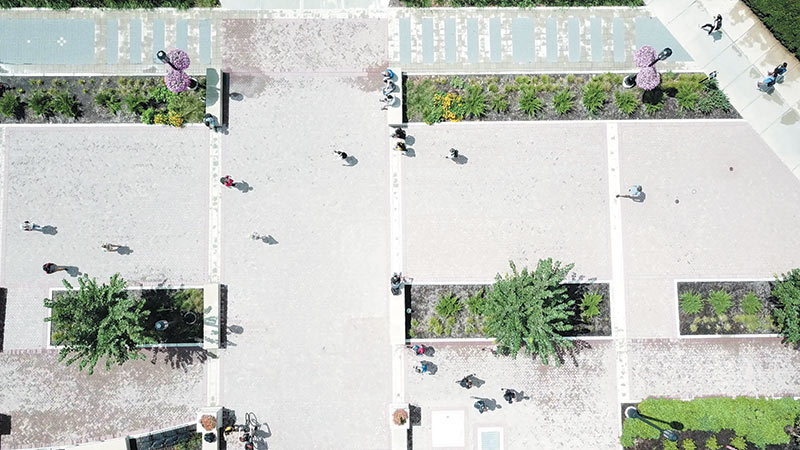Quantitative Evaluation of Pedestrian Movement Models: A Real Many-Body Problem
Quantitative Evaluation of Pedestrian Movement Models: A Real Many-Body Problem
2018 SPS Chapter Research Award
Project Lead: Adam Kline
Chapter Advisor: Rafael Lang
Project Abstract: A number of papers have been published since 2000 that attempt to model pedestrian crowd flow dynamics using basic equations of motion. Here we undertake a study to collect research-grade pedestrian data on campus using an off-the-shelf aerial drone and then test pedestrian dynamics models with those data.
 Many researchers have attempted to model pedestrian crowd flow dynamics using basic equations of motion. Our chapter wanted to know whether a visible-range camera mounted to an unmodified quadcopter drone could be used to effectively collect quantitative crowd flow data, and, if so, which theoretical models do a good job of modeling reality.
Many researchers have attempted to model pedestrian crowd flow dynamics using basic equations of motion. Our chapter wanted to know whether a visible-range camera mounted to an unmodified quadcopter drone could be used to effectively collect quantitative crowd flow data, and, if so, which theoretical models do a good job of modeling reality.
Prior to the year 2000, there were two foundational works in this area. In 1974, Leroy Henderson modeled a crowd as a sort of gas whose dynamics are determined by the Boltzmann transport equation.1 In 1995, Dirk Helbing and Peter Molnar modeled humans as psychologically driven automata subject to reasonably defined social forces.2 These forces, which include a motivational force, a general attractive force, and an interpersonal repulsive force, act on the agent as though it were a particle obeying Newtonian mechanics.
A number of predictive models were published in the 2000s that expand upon these works. A few focused on panicked crowd dynamics and flow through pinch points, while others attempted to advance the social force model. We aimed to provide a critical, quantitative evaluation of these theories based on data as well as an example of how to collect such data.
Our data consisted of aerial footage of pedestrian movement collected with a DJI Mavic Pro quadcopter drone. Initially, we took data at heights ranging from 25 to 75 m above ground level. To avoid alerting people to the drone’s presence (and thereby affecting behavior) and to have a good balance between adequate number of features for detection and scope of detection, we eventually fixed the recording height to 35 m.
The primary technical challenge was translating the raw footage into identified trajectories. This was broken down into two problems: detecting humans from the birds-eye view and then running single-particle tracking. Birds-eye human detection was done via machine learning; however, we had to overcome two complicating factors—the large 4 K resolution of the drone and the fact that the angle of the camera view (directly above) was sufficiently unique that we could not find an adequate existing dataset for training.
To resolve the first issue, the field of view was split into sections, and then the outputs for all of the sections were stitched together after processing. The absence of an available training dataset was solved through the manual tagging of collected data. Footage of students walking between passing periods was collected and used as raw data that SPS chapter members manually tagged. In this way, a dataset of people viewed from above was created and used to help train the model.
Once human detections were made, we ran single-particle tracking to look at the underlying dynamics of the situation. Single-particle tracking has heavy applications in protein tracking in biophysics, so many libraries exist to generate trajectories, agnostic as to how the detections themselves were created. We used trackpy, an open-source and easy-to-use tracking toolkit.
After processing the data, we began to compare it to the aforementioned models. However, we quickly found that most of the papers offered very little description of how their models were implemented computationally. All the papers presented the basic equations, but the algorithms offered only a very general outline. The details of many aspects of the models were simply omitted—for example, how the models set the pedestrians’ directional inclination (e.g., destination) and how the models defined obstacles. Due to the difficulty in reproducing accurate models, ambiguities and missing information, and time constraints, we were unable to conduct a satisfactorily thorough and conclusive evaluation of the models we studied.
Although we did not achieve all of our goals, we successfully demonstrated that research-grade empirical pedestrian data can be collected by a combination of an off-the-shelf commercial drone with no additional modification and modern computational tools enabled by the recent development of machine learning. Although there are several legal restrictions that apply to drones (e.g., requirement of permission when flying in crowded cities), we believe that the data collection method we have developed is nonetheless viable for many purposes.
1. Leroy F Henderson. On the fluid mechanics of human crowd motion. Transp. Res., 8(6):509–515, 1974.
2. Dirk Helbing and Peter Molnar. Social force model for pedestrian dynamics. Phys. Rev. E, 51(5):4282, 1995.
For more details on this project, visit our SPS award page at spsnational.org/awards/sps-chapter-research-award/2018/purdue-university.
